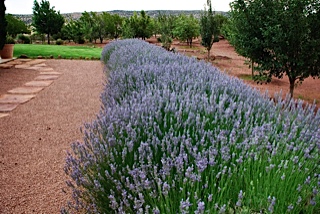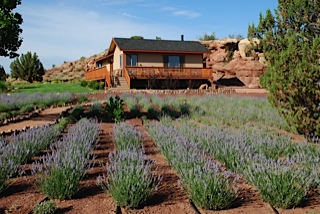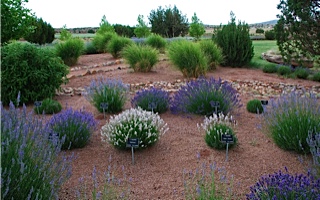 Loading... Please wait...
Loading... Please wait...- Call us on 928-337-2289
- The Farm
- Blog
- Lavender Festival
- Wish Lists
- My Account
- 0.00
Categories
Quick Links
Growing
Lavender is wonderful as a landscaping plant. It combines well with so many other plants in the landscape. It is easy to grow, draught resistant when established, and repellent to insects and deer. With its silvery green leaves, it is lovely even when it is not in bloom. As an added bonus it produces fragrant purple lavender flowers and is useful for crafting and cooking.
Lavender plants are perennial so once you plant them; you can enjoy them for many years. The following are a few ideas of how you can add lavender to enhance your landscape:
• In a Herb or Rock Garden
• As a Hedge
• Lining a Driveway or a Path
• Grouped with other Perennial and Annual Plants
• Hillside Planting
• In Planters or Pots
Landscaping Ideas: Hedge, Front Yard, Small Area, Several Lavender Varities in a Rock Garden
 |
 |
 |
 |
Cultivation
Lavender is native to rocky regions with alkaline soil and a lot of sun so it's our job to create conditions to make it feel at home. Lavender needs full sun to grow densely and have prolific blooms.
Lavender, in general, is a pretty tough plant but if there were one weakness that would get it every time it would be poor drainage. Lavender plants should never be planted where the soil or plant will be inundated with water. If you have very soggy winter conditions, plant on raised beds to increase drainage of water away from the plant.
Transplanting
Plant in well-drained soil. Lavender prefers a light, sandy soil with somewhat low fertility. In very hot regions, lavender can be planted in partially shaded areas or in large pots.
Dig holes approximately three times the volume of the pot size you are planting. It is highly recommended adding a small amount of organic Yum-Yum mix or an all purpose type fertilizer in each hole when transplanting.
It is important that the woody stem of the plant is not covered with soil, planting too deep can lead to stem rot. To release plant, gently remove it out of the container. Avoid grabbing by the stem or top of the plant. Make an effort to keep the majority of the roots pointed downwards when placing the plant in the hole.
Water the plant thoroughly and remember when transplanting in summer that it may look wet but the plant may have sucked the immediate soil around its roots dry in the first few weeks after transplant. After established, be careful not to over-water.
Caring for Lavender
The care of lavender is especially easy. It does not require a lot of nurturing and in fact too much watering after established and also using the incorrect fertilizer will often destroy the plants.
Bees love lavender and when you are harvesting they will surround the plant but they will seldom bother you because they are so entranced and calm from the lavender. Lavender is known for its calming effect and that is self-evident from the habit of the bees.
Pruning right after or during bloom allows the plant to recover and put on some new growth before winter. When harvesting the flower spikes, do not cut more than 1/2 inch into the plant making sure you do not prune into the woody portion of the plant. You want to prune to make a nice round shape.
Plants need to be pruned every year to keep a dense round shape and to ensure prolific bloom.
In colder winter climates, lavender may go dormant and the leaves will appear grayish-green. you plant is alive and well and is resting and developing its root structure. By late spring, the lavender plant will green-up.

